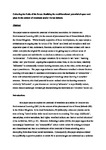Culturing the fruits of the forest: realising the multifunctional potential of space and place in the context of woodland and/or Forest Schools
| dc.contributor.author | Morgan, Alun | |
| dc.date.accessioned | 2018-05-30T12:00:57Z | |
| dc.date.issued | 2018-03-01 | |
| dc.identifier.issn | 2206-3110 | |
| dc.identifier.issn | 2522-879X | |
| dc.identifier.uri | http://hdl.handle.net/10026.1/11605 | |
| dc.description.abstract |
This paper seeks to explore the potential of woodland as a milieu for Outdoor and Environmental Learning (OEL) in the context of phenomenal rise of Forest Schools (FS) in the United Kingdom. Whilst broadly supportive of these developments, the paper adopts a critical stance in arguing that the notion of the ‘forest’ as a literal and metaphoric wild and expansive space of risk, excitement, freedom, exploration and intimate contact with nature which underpins the original FS concept seems to be giving way to a diluted sense of controlled spaces and activities for curriculum enrichment, a process referred to as ‘scolonisation’. Furthermore, the paper considers FS in relation to two ‘axes’: ‘learning milieu’ and ‘practitioners’, arguing that a spectrum exists from, on the one hand, relatively ‘deforested’ to substantially wooded learning contexts; and, on the other, novice through to expert practitioners. The paper argues that the most efficacious woodland-oriented Outdoor Learning will take place in woodland environments under the facilitation of ‘silvanatives’ – those with substantial practical and pedagogical knowledge about learning in woodland contexts. However, this ideal potential is under-realised when the learning context is relatively ‘deforested’, or practitioners are relatively ‘silvanaïve’ or superficially trained, trends that are seemingly increasingly characterising the movement as it becomes ‘scaled-up’. | |
| dc.format.extent | 117-130 | |
| dc.language | en | |
| dc.language.iso | en | |
| dc.publisher | Springer Science and Business Media LLC | |
| dc.title | Culturing the fruits of the forest: realising the multifunctional potential of space and place in the context of woodland and/or Forest Schools | |
| dc.type | journal-article | |
| dc.type | Journal Article | |
| plymouth.issue | 1 | |
| plymouth.volume | 21 | |
| plymouth.publication-status | Published | |
| plymouth.journal | Journal of Outdoor and Environmental Education | |
| dc.identifier.doi | 10.1007/s42322-017-0008-z | |
| plymouth.organisational-group | /Plymouth | |
| plymouth.organisational-group | /Plymouth/Faculty of Arts, Humanities and Business | |
| plymouth.organisational-group | /Plymouth/Faculty of Arts, Humanities and Business/Plymouth Institute of Education | |
| plymouth.organisational-group | /Plymouth/REF 2021 Researchers by UoA | |
| plymouth.organisational-group | /Plymouth/REF 2021 Researchers by UoA/UoA23 Education | |
| plymouth.organisational-group | /Plymouth/Research Groups | |
| plymouth.organisational-group | /Plymouth/Research Groups/Institute of Health and Community | |
| plymouth.organisational-group | /Plymouth/Users by role | |
| plymouth.organisational-group | /Plymouth/Users by role/Academics | |
| dcterms.dateAccepted | 2018-02-11 | |
| dc.rights.embargodate | 2019-2-20 | |
| dc.identifier.eissn | 2522-879X | |
| dc.rights.embargoperiod | 12 months | |
| rioxxterms.versionofrecord | 10.1007/s42322-017-0008-z | |
| rioxxterms.licenseref.uri | http://www.rioxx.net/licenses/under-embargo-all-rights-reserved | |
| rioxxterms.licenseref.startdate | 2018-03-01 | |
| rioxxterms.type | Journal Article/Review |


